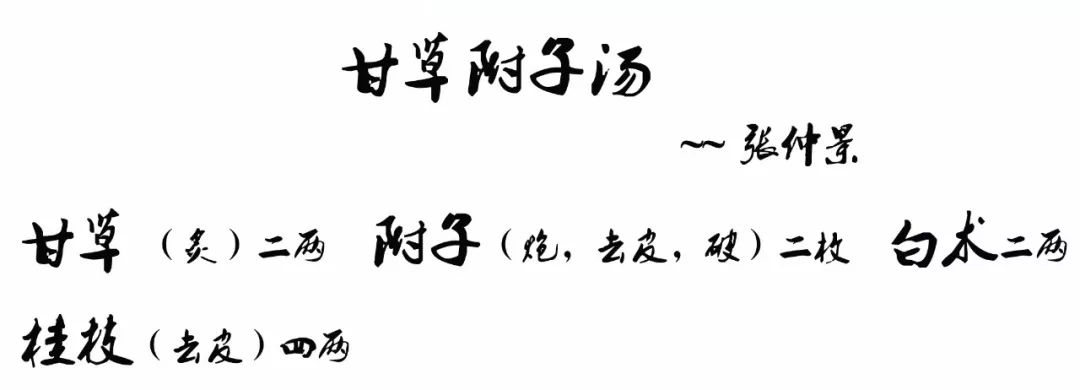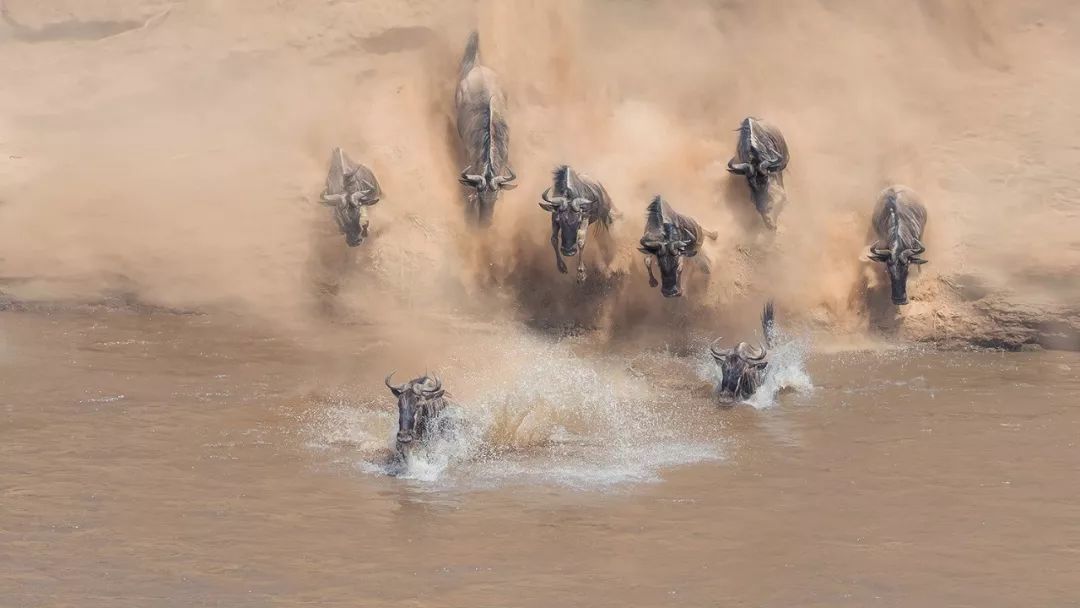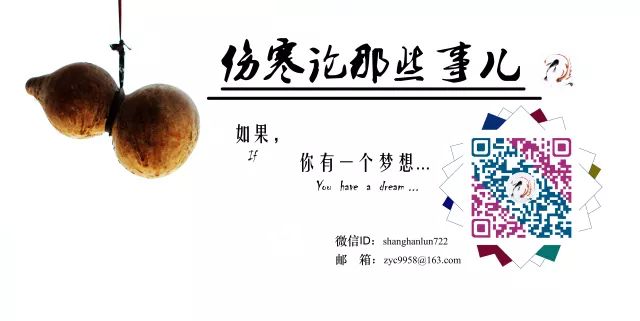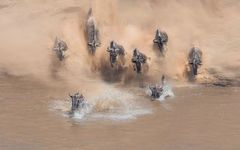
Second Section on the Treatment of Wind-Dampness Syndrome

Article 24
When wind and dampness attack together, causing joint pain and discomfort, with pulling pain that restricts movement, severe pain upon approach, sweating and shortness of breath, difficulty in urination, aversion to wind and reluctance to remove clothing, or slight swelling of the body, the prescription is Gan Cao Fu Zi Tang (Licorice and Aconite Decoction).

Take the four ingredients, boil with six liters of water until three liters remain, and strain. Warmly take one liter, three times a day. If slight sweating occurs, it indicates resolution. If the patient can eat but still feels discomfort from sweating, take five portions. If one liter seems too much, six to seven portions is preferable.

Introduction: The “Essentials of the Golden Chamber” is edited according to the classification method in Liu Duozhou’s commentary on the text. Annotations are primarily drawn from works of Qing Dynasty and modern physicians, and due to personal understanding, some bias may be present. Readers are encouraged to extract the essence and discard the dross, combining it with clinical practice and focusing on personal comprehension. Comments and contributions of famous discussions or personal annotations are welcome!


Commentary by Zi Heng
External invasion of wind, cold, and dampness leads to severe pain in the muscles and joints, with pulling pain causing difficulty in limb movement, and even slight movement can exacerbate the pain. Yang Qi is deficient, unable to secure the exterior, resulting in sweating, shortness of breath, and aversion to wind, with reluctance to remove clothing. The accumulation of dampness leads to difficulty in urination and slight swelling of the body. Treatment can be achieved with Gan Cao Fu Zi Tang, which warms Yang and dispels wind-dampness.


Qing Dynasty – You Yi’s “Heart of the Essentials of the Golden Chamber”
This is also a case of dampness overpowering a weak Yang. The treatment does not deviate from the principles of assisting Yang and dispersing dampness. The mention of slight sweating indicates resolution, not a proper sweating method, but rather that Yang has recovered and Yin has naturally resolved. Wind-dampness on the exterior should be resolved through sweating, as in the methods of Ma Huang Jia Zhu Tang (Ephedra and Atractylodes Decoction) and Ma Huang Xing Ren Yi Yi Ren Gan Cao Tang (Ephedra, Apricot Kernel, Job’s Tears, and Licorice Decoction). However, if sweating occurs with a weak exterior, one should not excessively induce sweating, hence the methods of Fang Ji Huang Qi (Stephania and Astragalus) to solidify the exterior and promote dampness. Bai Zhu (Atractylodes) and Fu Zi (Aconite) are used to supplement Yang for movement. If the exterior is weak without heat, one should not hastily induce Yang, hence the methods of Gui Zhi Fu Zi (Cinnamon Twig and Aconite) to warm the meridians and disperse dampness. Gan Cao Fu Zi Tang combines both supplementing the middle and dispersing. These several formulas, along with Zhang Zhongjing’s careful diagnosis and variations in application, can be seen.


Qing Dynasty – Wu Qian’s “Medical Canon of the Golden Chamber”
Note:
When wind and dampness attack together, the body feels heavy and painful, and one cannot turn or shift. The dampness overpowers the wind. If there is pulling pain that restricts movement, it indicates that wind overcomes dampness. Severe pain upon approach, sweating, shortness of breath, and aversion to wind indicate that wind evil is excessive. Difficulty in urination indicates internal accumulation of dampness. Slight swelling of the body indicates external wind-dampness. The treatment with Gan Cao Fu Zi Tang focuses on inducing slight sweating to dispel wind primarily, and then to eliminate dampness secondarily. The previous two articles detail the significance of wind-dampness to clarify its treatment.


Qing Dynasty – Gao Xueshan’s “Gao’s Commentary on the Essentials of the Golden Chamber”
This article emphasizes the importance of the word “wind”. The symptoms primarily include sweating and aversion to wind, indicating that wind is the root cause while dampness is the manifestation. Therefore, the intention of the formula with Gui Zhi (Cinnamon Twig) is to promote the circulation of sweat to resolve wind, while also incorporating Bai Zhu (Atractylodes) to resolve dampness. Dampness flows into the joints and can transform into heat, while wind is also a Yang heat evil, thus both heats contend in the joints, causing discomfort and pain. The nature of wind and fire is to move and expand, hence the pulling pain. Wind-dampness accumulates around the joints, causing restriction in movement and pain upon approach. Wind evil disperses the exterior, hence sweating occurs. Dampness obstructs the lung orifices, leading to shortness of breath. Difficulty in urination indicates that wind-dampness and heat are mutually reinforcing, causing Qi stagnation. Aversion to wind indicates that sweating has dispersed the exterior, leading to fear of wind invasion. Slight swelling indicates that wind-dampness obstructs the meridian Qi response. This wind is heavy, hence in addition to Gan Cao (Licorice), Bai Zhu (Atractylodes), and Fu Zi (Aconite) to warm the spleen and dry dampness, one must also follow Gui Zhi to resolve wind-dampness.


Qing Dynasty – Huang Yuanyu’s “Suspension of the Golden Chamber”
Dampness flows into the joints, causing discomfort and pulling pain, restricting movement and causing severe pain upon approach. Sweating and shortness of breath, difficulty in urination, and dampness obstructing the lung’s ability to descend, hence shortness of breath and sweating. The liver’s wood cannot ascend, hence water is obstructed, leading to urinary difficulty. Yang is restrained and cannot reach, resulting in aversion to cold wind. Qi stagnation leads to visible swelling. Gan Cao Fu Zi Tang consists of Gan Cao (Licorice), Bai Zhu (Atractylodes) to strengthen the spleen and dry dampness, and Fu Zi (Aconite), Gui Zhi (Cinnamon Twig) to warm Yang and promote Qi flow.


Qing Dynasty – Cao Yingfu’s “Subtlety of the Golden Chamber”
This is also discussed in the previous section regarding the Tai Yang chapter in “Shang Han Lun”. The principle is that water and dampness encounter cold to freeze, and encounter heat to melt, which is the easiest principle to understand. When wind and dampness attack together, leading to joint pain and discomfort, with pulling pain that restricts movement, and severe pain upon approach, this indicates that cold dampness has entered the joints, obstructing the flow of Qi and blood (similar to the pain caused by sores and ulcers, as pain arises from obstruction). If there is obstruction, there is pain. This condition can suddenly manifest as dampness, and if it persists, it can develop into a chronic condition. Sweating and shortness of breath are also similar to chronic conditions. Dampness is still on the exterior, hence aversion to wind and reluctance to remove clothing, or slight swelling, which is not purely an internal condition. Wind and Yang draw outward, hence difficulty in urination. The symptoms and origins are similar to chronic conditions, hence the treatment methods are also interrelated. Gan Cao Fu Zi Tang uses Gan Cao (Licorice), Bai Zhu (Atractylodes), and Gui Zhi (Cinnamon Twig), with two pieces of Fu Zi (Aconite) and five pieces of Wu Tou (Aconite) and three taels of roasted Licorice. However, if there is slight swelling, it may be necessary to use Ma Huang (Ephedra) to induce sweating. Zhang Zhongjing’s avoidance of this indicates that dampness evil has penetrated the joints, requiring a gentle approach. Otherwise, inducing excessive sweating may lead to wind dispersing but dampness remaining, which would be ineffective.


Qing Dynasty – Shen Mingzong’s “Zhang Zhongjing’s Essentials of the Golden Chamber”
This is a case of Yang deficiency with excessive evil. Wind-dampness injures the Ying and Wei, flowing between the joints and meridians, with evil and righteousness contending, causing joint pain and discomfort, with Yin blood stagnation and Yang deficiency leading to difficulty in movement, and severe pain upon approach. The Wei Yang is deficient, leading to sweating, while insufficient internal Qi results in shortness of breath and difficulty in urination. The exterior Yang is deficient, leading to aversion to wind and reluctance to remove clothing, with Yang injury causing Qi stagnation, hence slight swelling. The relationship between exterior and interior, Yin and Yang, is one of deficiency and excess, hence Gan Cao (Licorice), Bai Zhu (Atractylodes), and Fu Zi (Aconite) are used to assist Yang, strengthen the spleen, eliminate dampness, and protect against sweating. Gui Zhi promotes the circulation of Ying and Wei, dispelling wind, thus supplementing while also inducing release, without driving away evil, allowing wind-dampness to resolve naturally. The wind-dampness syndrome must recognize the absence of heat and spontaneous sweating, indicating severe Yang Qi deficiency, hence the priority is to secure Yang.


Qing Dynasty – Chen Xiuyuan’s “Shallow Annotation of the Essentials of the Golden Chamber”
When cold damage combines with wind-dampness, as previously detailed, if the condition is severe, the medication must also be milder. Now, when wind and dampness attack together, having already penetrated deeply, causing joint pain and discomfort, with pulling pain that restricts movement, and severe pain upon approach, this indicates that the three evils of wind, cold, and dampness obstruct the righteous Qi, preventing its circulation. Sweating and shortness of breath, difficulty in urination, aversion to wind and reluctance to remove clothing, or slight swelling indicate that the Ying Qi and Wei Qi are both affected, primarily due to the failure of the original Yang Qi in the lower abdomen. The goal is to restore Yang, warm the Qi, and ensure smooth circulation of the meridians, allowing Yin Qi to be warmed and the water sources to flow. Gan Cao Fu Zi Tang is the main prescription.
This continues from the previous section, discussing the combination of wind and dampness. For external conditions, the goal is to quickly dispel them, while for deeper conditions, the key is gentle treatment. The teacher feared that three pieces of Fu Zi (Aconite) might be excessive, as its nature is fierce and urgent, and the joints may not open immediately, hence dampness may not disperse quickly, leading to excessive sweating without complete resolution of the evil. Therefore, one piece was reduced, and ginger and jujube were omitted, with Gan Cao as the monarch to ensure gentleness.


Liu Duozhou’s “Commentary on the Essentials of the Golden Chamber”
This article discusses the differentiation and treatment of wind-dampness syndrome with Yang Qi deficiency. The patient is affected by wind, cold, and dampness, with the three evils prevailing on the surface of the joints, while Yang Qi is also deficient, leading to joint pain and pulling pain that restricts movement, with severe pain upon approach. Yang deficiency fails to secure the exterior, resulting in sweating and shortness of breath; excessive cold dampness leads to difficulty in urination and aversion to wind, with reluctance to remove clothing or slight swelling, reflecting the excess of evil Qi and deficiency of Yang.
The treatment should be Gan Cao Fu Zi Tang, which assists Yang, warms the meridians, and benefits Qi while transforming dampness. In the formula, Gan Cao (Licorice) and Bai Zhu (Atractylodes) strengthen the spleen and transform dampness; Fu Zi (Aconite) and Gui Zhi (Cinnamon Twig) warm Yang, promote Qi flow, and disperse wind-dampness. This formula supports the righteous Qi while expelling the evil, balancing both aspects for the treatment of wind-dampness-related heart disease.


Hu Xishu’s “Lectures on the Essentials of the Golden Chamber”
When wind and dampness attack together, causing joint pain and discomfort, pulling pain indicates a severe restriction in movement, making it difficult to bend or stretch. The pain is exacerbated upon approach, indicating that even slight contact causes significant pain. Sweating and shortness of breath indicate a weak exterior. Shortness of breath here indicates that Qi is surging upwards, causing water retention in the stomach, leading to shortness of breath. The aversion to wind and reluctance to remove clothing indicates a state of internal cold. This indicates that the condition has entered a Yin state, with Yang deficiency. The excessive sweating and severe aversion to wind, even reluctance to remove clothing, indicate that the internal cold is more severe than previously described, hence the pain is also more intense, and there may be slight swelling due to dampness.
The prescription is Gan Cao Fu Zi Tang, derived from Gui Zhi Gan Cao Tang (Cinnamon Twig and Licorice Decoction). In “Shang Han Lun”, there is a formula of Gui Zhi Gan Cao Tang, which consists of these two herbs, primarily treating upward surging Qi and palpitations, with Gui Zhi addressing the upward surging Qi. This section emphasizes the severity of upward surging Qi, with water not descending, hence the body retains dampness, leading to shortness of breath. This indicates that the internal dampness is significant, and the pulse is more deficient. This indicates the Gui Zhi Gan Cao Tang syndrome, and for joint pain due to wind-dampness, this formula can be used. The previous formula is based on Gui Zhi, omitting Shao Yao (Peony) and adding Fu Zi (Aconite). If dampness is significant, Bai Zhu (Atractylodes) should also be added. This text illustrates the variations in treatment based on the severity of dampness.
If there is slight swelling and shortness of breath, regardless of whether internal or external dampness is predominant, Bai Zhu (Atractylodes) is necessary, as Fu Zi (Aconite) also treats bi pain. If dampness is mild, using Fu Zi alone may suffice, indicating a state of internal cold. In acute episodes, if there is no indication for Fu Zi, one cannot use it, as in the previous formulas of Ma Huang Jia Zhu Tang (Ephedra and Atractylodes Decoction) or Ma Huang Xing Ren Yi Yi Ren Gan Cao Tang (Ephedra, Apricot Kernel, Job’s Tears, and Licorice Decoction). This indicates a transition to a Yin deficiency syndrome, hence Fu Zi must be included. Both sections illustrate this, but the methods of application vary. In clinical practice, the combination of Gui Zhi Tang with Bai Zhu and Fu Zi is frequently used, especially for chronic joint pain where the pulse is not floating, and the condition has persisted for a long time, indicating that these formulas are appropriate. After discussing all these, we will further elaborate on the treatment of wind-dampness.
This formula requires six liters of water, boiled down to three liters, strained, and taken warm at one liter, three times a day. If slight sweating occurs, it indicates resolution. If the patient can eat, but still feels discomfort from sweating, take five portions. If one liter seems excessive, six to seven portions is preferable. This illustrates the importance of dosage in the application of any formula. The ancient practitioners would prepare the decoction and divide it into several doses, which relates to the quantity taken at one time. The same formula can have significant differences based on the dosage, hence caution is necessary, and starting with a smaller amount is advisable, gradually increasing as needed. This indicates the concern that one liter may be too much, hence six to seven portions is preferable.
This section concludes the discussion on dampness, which can be categorized into two major types: one is internal dampness, arising from difficulty in urination, leading to internal stagnation, which can cause delirium, as detailed later in the section on jaundice. The other type is dampness bi, which can also occur due to dampness, and the treatment for this is similar to that for wind-dampness, hence no separate treatment method is proposed. Additionally, the ancient texts discuss the external invasion of wind and dampness, which is worth studying. The principles are clear. The treatments mentioned for acute conditions involve using sweating-inducing herbs combined with damp-dispelling herbs, such as Ma Huang Jia Zhu Tang (Ephedra and Atractylodes Decoction) or Ma Huang Xing Ren Yi Yi Ren Gan Cao Tang (Ephedra, Apricot Kernel, Job’s Tears, and Licorice Decoction). If the condition persists, transitioning to a Yin deficiency syndrome occurs, hence Fu Zi must be included, along with Bai Zhu if dampness is present. This concludes the discussion on dampness, but further elaboration will be provided in the next chapter.

It is our responsibility to inherit and promote Traditional Chinese Medicine!
Copyright Notice
Copyright Notice: Some content in this article is excerpted from “Commentary on the Essentials of the Golden Chamber” by Liu Duozhou; and “Lectures on the Essentials of the Golden Chamber” by Hu Xishu. The purpose of reprinting is to disseminate knowledge of Traditional Chinese Medicine culture, and the copyright belongs to the relevant rights holders. If there are any improper uses, please feel free to contact us for negotiation. The section “Commentary by Zi Heng” is original content, please indicate the source when reprinting.

Full Chapter Content
Article 1: Tai Yang disease, fever without sweating, and aversion to cold, is called “stiffness”.
Article 2: Tai Yang disease, fever with sweating and no aversion to cold, is called “soft stiffness”.
Article 3: Tai Yang disease, fever, with a pulse that is deep and thin, is called “stiffness”, which is difficult to treat.
Article 4: If sweating is excessive, it leads to stiffness.
Article 5: Wind disease leads to stiffness; if sweating is induced again, it must be restricted.
Article 6: Even if the patient has body pain, sweating should not be induced; if sweating occurs, it leads to stiffness.
Article 7: If the patient has body heat and cold feet, stiff neck, aversion to cold, occasional head heat, red face, red eyes, and sudden mouth closure, it indicates stiffness. If sweating is induced, the cold dampness will worsen, and the exterior will become more deficient, leading to severe aversion to cold. If sweating has already occurred, the pulse will feel like a snake.
Article 8: If there is sudden abdominal distension, with a pulse as usual, and a retracted pulse, it indicates stiffness.
Article 9: The pulse of stiffness is tight like a string, moving straight up and down.
Article 10: Stiffness can occur with moxibustion sores, which are difficult to treat.
Article 11: In Tai Yang disease, if all symptoms are present, the body is strong, and the pulse is deep and slow, this indicates stiffness, and the prescription is Guo Lou Gui Zhi Tang (Trichosanthes and Cinnamon Twig Decoction).
Article 12: In Tai Yang disease, if there is no sweating but urination is scant, Qi surges upwards in the chest, and the mouth is closed and cannot speak, it indicates impending stiffness; the prescription is Ge Gen Tang (Kudzu Decoction).
Article 13: Stiffness as a disease, with fullness in the chest and mouth closure, unable to lie down, and legs cramping, may lead to teeth grinding; it can be treated with Da Cheng Qi Tang (Major Order the Qi Decoction).
Article 14: In Tai Yang disease, if there is joint pain and discomfort, with a deep and thin pulse, this is called damp bi. The symptoms of damp bi include difficulty in urination and rapid bowel movements, but one should focus on relieving urination.
Article 15: In damp conditions, the entire body aches, with fever and a yellowish complexion.
Article 16: In damp conditions, the person sweats only from the head, with a stiff back, desiring to be covered and facing the fire. If purged too early, it leads to belching, or fullness in the chest, with difficulty in urination, and a tongue resembling a fetus, indicating heat in the lower abdomen and cold in the chest, with thirst and inability to drink, leading to dryness and discomfort.
Article 17: If a damp patient is purged, sweating occurs on the forehead, slight wheezing, and urination is easy, they may die; if diarrhea does not stop, they may also die.
Article 18: When wind and dampness attack together, causing the entire body to ache, the treatment should induce sweating for resolution. If it is continuously cloudy and rainy, the physician may say that this can induce sweating; if the sweating disease does not resolve, why? Because inducing sweating leads to significant wind removal, but dampness remains, hence it does not resolve. If treating wind-dampness, inducing slight sweating is sufficient to eliminate both wind and dampness.
Article 19: In damp conditions, if the body aches, with fever, a yellowish complexion, headache, nasal congestion, and discomfort, the pulse is large, and the patient can eat and drink, with a harmonious abdomen, the disease is in the cold dampness of the head, hence nasal medication will resolve it.
Article 20: In damp conditions, if the body feels uncomfortable, one can use Ma Huang Jia Zhu Tang (Ephedra and Atractylodes Decoction) to induce sweating, but caution against using fire to attack.
Article 21: If the patient has body aches, fever, and the condition worsens in the afternoon, it is called wind-dampness. This condition is caused by sweating in the wind or prolonged exposure to cold. It can be treated with Ma Huang Xing Ren Yi Yi Ren Gan Cao Tang (Ephedra, Apricot Kernel, Job’s Tears, and Licorice Decoction).
Article 22: Wind-dampness, with a floating pulse, heavy body, sweating, and aversion to wind, is treated with Fang Ji Huang Qi Tang (Stephania and Astragalus Decoction).
Article 23: After eight or nine days of cold damage, if wind-dampness attacks, causing body pain and discomfort, with an inability to turn or shift, without nausea or thirst, and a floating, weak, and rough pulse, the prescription is Gan Cao Fu Zi Tang (Licorice and Aconite Decoction). If the stool is hard and urination is self-sufficient, remove Gui Zhi and use Bai Zhu Tang (Atractylodes Decoction).
Article 24: When wind and dampness attack together, causing joint pain and discomfort, with pulling pain that restricts movement, severe pain upon approach, sweating and shortness of breath, difficulty in urination, aversion to wind and reluctance to remove clothing, or slight swelling of the body, the prescription is Gan Cao Fu Zi Tang (Licorice and Aconite Decoction).
Article 25: In Tai Yang heat, fever and aversion to cold, with a heavy and painful body, the pulse is wiry, thin, and slow. If urination is present, it is scant; if there is slight exertion, the body becomes hot, and the mouth opens with dry teeth. If sweating is induced, the aversion to cold will worsen; if warming needles are applied, the fever will worsen; if purged multiple times, it will lead to severe urination.
Article 26: In Tai Yang heat, sweating and aversion to cold, with body heat and thirst, the prescription is Bai Hu Jia Ren Shen Tang (White Tiger Decoction with Ginseng).
Article 27: In Tai Yang heat, with body heat, heavy pain, and a weak pulse, this is caused by summer damage from cold water, leading to water movement in the skin; the prescription is Yi Wu Guo Ti Tang (One Item Melon Stem Decoction).

Thoroughly read and memorize

Article 24: When wind and dampness attack together, joint pain and discomfort, with pulling pain that restricts movement, severe pain upon approach, sweating and shortness of breath, difficulty in urination, aversion to wind and reluctance to remove clothing, or slight swelling of the body, the prescription is Gan Cao Fu Zi Tang (Licorice and Aconite Decoction).





